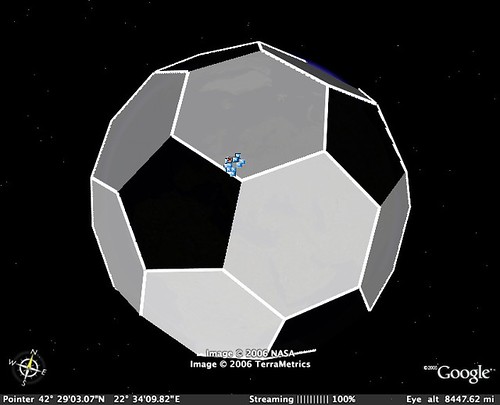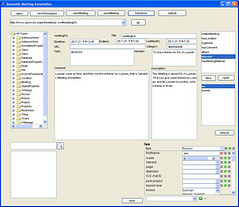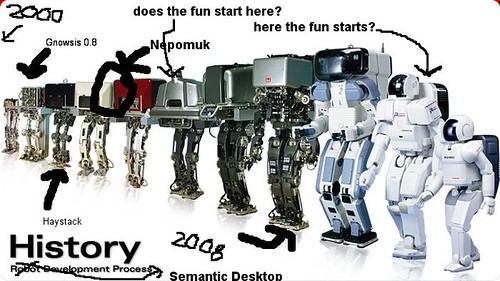Dazzled by the craze for the soccer wm in Germany, I was wondering what to do with soccer. Then, yesterday night it struck me and I knew: the world is a soccer ball! We are living on a big leather ball, floating through space.

So behold: the ultimate Google Earth hack:
The world is a soccer ball!
Click to see yourself (you need to have installed
Google Earth first):
howgermansseetheworld.kml
The full story:
a KML overlay for google earth, created in painstaking work by Leo Sauermann,
This is how many people view the world these days. It is the biggest soccer ball that has ever been sighted. yes, very big, even bigger then the one
spotted by Google previously.
How this was done?
First of all, it is important to know what a soccer ball is. A soccer ball is a "cut-away icosaeder". I read some details this webpage:
mathematische-basteleien.de/fussball.htm.
Then I looked for a way to model it in KML. As I have never done KML before, I had to look for tutorials and docu first.
Ok, the easiest way is to assume the center of the world as center of the soccer ball.
I needed the coordinates of the corner-points, these I found in a Java snippet that creates a rotating soccer ball.
This
snippet of java helped me.
I copied the code and fumbled around for three hours until I could convert the xyz coordinates to lat/lon coordinates.
Also, Google Earth gave me headaches as it discriminates on polygons, if you draw then clockwise or counter-clockwise the color gets changes
(argh! And I thought my stlye was wrong).
After the corner-coordinates were setup, I created a KML file with the corners numbered.
Then I had to find all six-corner and five-corner objects and added them to an array.
Finally, I added
all real soccer stadiums for the WM
and the
previous biggest soccer ball
to the KML, as sugar on top - for you users.
Still open is how to put the FIFA logo on the ball...
enjoy, if you have questions:
leo@gnowsis.com
Leo Sauermann 2006
Sources
The source code and all needed to go on is on my homepage:
soccer.zip.
Also
in SVN in the fuzzbutt project.
Copyright notice
This KML is licensed under creative-commons Attribution license
http://creativecommons.org/licenses/by/2.5/
inspiration and code taken from:
- http://www.bigsoccer.com/forum/archive/index.php/t-279086.html
- http://www.gearthblog.com/blog/archives/2006/05/worlds_biggest.html
- http://www.mathe-online.at/mathint/wfun/i.html#bogenmass
- http://earth.google.com/kml/kml_tags.html
- http://www.jjam.de/Java/Applets/3D_Effekte/Fussball.html












womens designer leather jackets ::::: childrens winter jackets ::::: cheap winter jackets for women ::::: winter running jacket ::::: maternity winter jackets ::::: kids leather coats ::::: hooded leather bomber jacket ::::: ladies flying jacket :::::